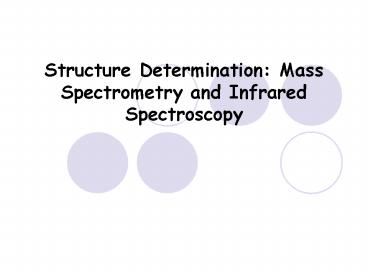Structure Determination: Mass Spectrometry and Infrared Spectroscopy - PowerPoint PPT Presentation
1 / 38
Title:
Structure Determination: Mass Spectrometry and Infrared Spectroscopy
Description:
Using Spectroscopy to Identify a Molecule ... with the molecular formula of an unknown compound and different types of spectra ... – PowerPoint PPT presentation
Number of Views:99
Avg rating:3.0/5.0
Title: Structure Determination: Mass Spectrometry and Infrared Spectroscopy
1
Structure Determination Mass Spectrometry and
Infrared Spectroscopy
2
Topics to discuss
- What is Spectroscopy?
- Mass Spectrometry
- What is it?
- How does it work and why is it useful?
- How to interpret a mass spectrum
- Common Fragments in MS
- IR Spectroscopy
- What is it?
- Why is it useful?
- How to interpret an IR spectrum
- Common IR absorptions
- Using Spectroscopy to Identify a Molecule
3
Intro to Spectroscopy
- Q What is Spectroscopy?
- Q How does it work?
4
Intro to Spectroscopy
- Q Why do we need it?
- Q How many kinds are there?
5
Mass Spectrometry (MS)
- Q What is it?
6
Mass Spectrometry (MS)
- Q How does it work, and why is it useful?
7
The Mass Spectrum
- Q What is a mass spectrum?
- Q What is important?
8
How to interpret a MS
- The way molecular ions break down can produce
9
Mass Spectral Fragmentation of Hexane
- Hexane (m/z 86 for parent) has peaks at m/z
71, 57, 43, 29
10
Mass-Spectral Behavior of Some Common Functional
Groups
- Functional groups cause
- Alcohols, amines, ketones and aldehydes are all
functional groups that
11
Common Fragments in Alcohol MS
12
Common Fragments in Amines MS
13
Common Fragments in Ketones/Aldehydes MS
14
Spectroscopy of the Electromagnetic Spectrum
- Radiant energy is proportional to
- Different types are classified by
15
Absorption Spectra
- Organic compound exposed to electromagnetic
radiation can - Changing wavelengths to determine
- Energy absorbed is distributed
16
Infrared Spectroscopy (IR)
- Q What is it?
- Q Why is it useful?
17
Infrared Spectroscopy (IR)
- Q How does it work?
18
Infrared Spectroscopy (IR)
- Q What is an IR spectrum?
19
Interpreting Infrared Spectra
- Most functional groups absorb at
- In this example, the peak is centered at
1750cm-1. Whenever we see a peak at 1750cm-1, we
know that it represents
20
Interpreting Infrared Spectra
- Different functional groups will yield different
absorption spectra which arise from differences
in - In IR spectroscopy, various functional groups
vibrate at unique frequencies, resulting in - Thus, we can use the wavelength of absorption to
determine
21
Regions of the Infrared Spectrum
- 4000-2500 cm-1 N-H, C-H, O-H (stretching)
- 2500-2000 cm-1 CC and CN (stretching)
- 2000-1500 cm-1 double bonds (stretching)
- Below 1500 cm-1 fingerprint region
22
Infrared Spectra of Hydrocarbons
- C-H, C-C, CC, CºC have characteristic peaks
23
Infrared Spectra of Some Common Functional Groups
- Learn the most common ones. With all others, you
can use a IR frequency correlation table. - Most common in organic compounds
- sp2 C-H stretch
- sp3 C-H stretch
- CC stretch
- C-O stretch
- CO stretch
- O-H stretch
24
IR Alcohols and Amines
- OH 3400 to 3650 cm?1
- NH 3300 to 3500 cm?1
25
IR Aromatic Compounds
- Weak CH stretch at
- Weak absorptions in
- Medium-intensity absorptions at
26
IR Carbonyl Compounds
- Strong, sharp CO peak at
- Exact absorption characteristic of type of
carbonyl compound
27
CO in Ketones
- 1715 cm?1 in
- 1750 cm?1 in
- 1690 cm?1 in
28
CO in Esters
- 1735 cm?1 in
- 1715 cm?1 in
29
Using Spectroscopy to Identify a Molecule
- 1. Recall the type of information that each
spectrum provides - 2. Use the spectra to verify and refute the
existence of structural features - 3. Piece together the structural info to arrive
at a possible answer. - 4. Cross check your answer with each spectrum to
verify it.
30
A Combined Spectral Problem
- Typically, you will be provided with the
molecular formula of an unknown compound and
different types of spectra to use to determine
the structure of an unknown. - The key is to learn an approach to these types of
problems which works best for you, and use the
same systematic approach every time.
31
A Combined Spectral Problem
- First step should always be
32
A Combined Spectral Problem
- Next, look quickly at the IR spectrum.
- Notice the broad peak centered at 3400cm-1.
33
A Combined Spectral Problem
- Now, look at the mass spectrum.
34
A Combined Spectral Problem
35
A Combined Spectral Problem
- Now that we have figured out this piece, we only
need to find two more carbons. - There are two possible ways to do this
36
A Combined Spectral Problem
- We already know the fragmentation pattern shown
is likely in both. - In the bottom structure, we would also expect to
see loss of a methyl group
37
A Combined Spectral Problem
- We should now try to verify that it is the top
structure. - Remember that we have
- So, we have now cross checked our answer with the
spectra provided to verify it.
38
Summary
- What is Spectroscopy?
- Mass Spectrometry
- What is it?
- How does it work and why is it useful?
- How to interpret a mass spectrum
- Common Fragments in MS
- IR Spectroscopy
- What is it?
- Why is it useful?
- How to interpret an IR spectrum
- Common IR absorptions
- Using Spectroscopy to Identify a Molecule































